|
By John Pint
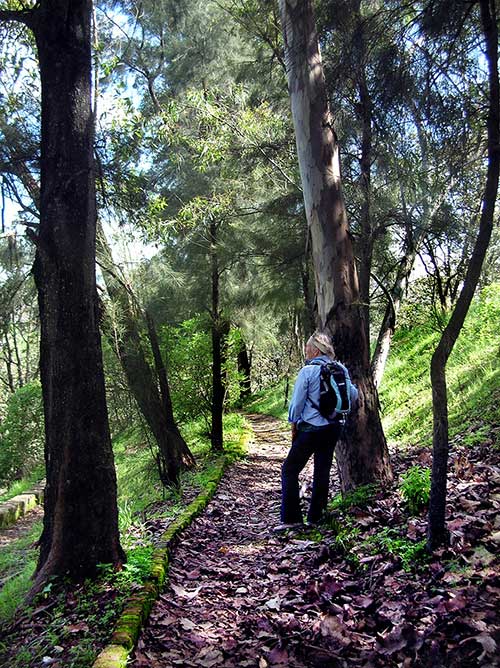 Pinar
de la Venta lies eight kilometers west of Guadalajara on the northern
edge of the Primavera Forest and has numerous woodsy stretches good for
hiking. Nature lovers in the community urged the administrators to
clean up some potential trails overgrown with weeds and the suggestion
was well received. As a result a 650-meter Andador de la Amistad was
recently inaugurated. Pinar
de la Venta lies eight kilometers west of Guadalajara on the northern
edge of the Primavera Forest and has numerous woodsy stretches good for
hiking. Nature lovers in the community urged the administrators to
clean up some potential trails overgrown with weeds and the suggestion
was well received. As a result a 650-meter Andador de la Amistad was
recently inaugurated.
This trail is a loop. It's a bit
curious because the first half of it consists of a wide, smooth path
through oaks and pines while the second half follows a deep, jungly
arroyo where walking is not exactly easy.
It was precisely this
aspect of the route which made me think it might make a good
interpretive trail: quite a variety of plants and trees can be seen
over a relatively short distance.
Now several interpretive
trails I've see in Mexico quickly “went to the dogs” as the explanatory
signs were destroyed either by weather or vandals. “Why not put both
the signs and their locations on the internet?” I thought, “along with
photos of what you are supposed to be seeing?”
I decided to
upload my “virtual signs” to Wikiloc.com, which can be downloaded as an
app to smartphones, for a very small fee. If your iPhone battery
doesn't die on you (as mine did), my Wikiloc route Andador
Amistad Pinar
will lead you along the trail and at each station, one click will give
you the name of what you are looking at and show photos as well.
Now if none of this makes any sense to you, forget the app and just
print out this high resolution Annotated
Map of the trail.
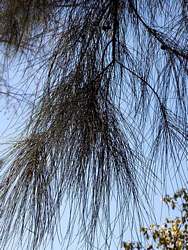 Station
1 of the Interpretive Trail takes you under a row of eucalyptus and
casuarina trees, both from Australia and not Mexican at all. While the
eucalyptus is easy to spot, the casuarina, with its long, wispy
“needles” could easily be confused with a pine tree, which it is not. Station
1 of the Interpretive Trail takes you under a row of eucalyptus and
casuarina trees, both from Australia and not Mexican at all. While the
eucalyptus is easy to spot, the casuarina, with its long, wispy
“needles” could easily be confused with a pine tree, which it is not.
The
trail heads north from here and after 40 meters, you'll be walking
directly underneath several gallitos (Station 2). This is Tillandsia, a
kind of bromelia called Air Plant in English and not a parasite.
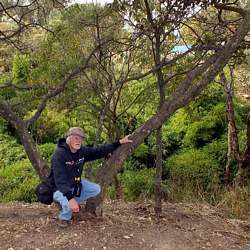 The
next important tree along the route is a tepame (3) or Fern-leaf acacia
in English. Next you find oak and pine trees (4) followed by a clethra
(5), a very commonly seen tree in the Primavera Forest. The
next important tree along the route is a tepame (3) or Fern-leaf acacia
in English. Next you find oak and pine trees (4) followed by a clethra
(5), a very commonly seen tree in the Primavera Forest.
At a
sharp curve we come to Station 6 and a plant called Barba de Chivo
(Goat's Beard). This, nature photographer Jesús Moreno assures me,
produces a bright red flower with long “whiskers” which hummingbirds
adore (See illustration in sidebar).
The trail now descends steeply, passing an embankment cut
where you can see plenty of jal, volcanic rubble including small pieces
of pumice (7). In the jal, which gives Jalisco its name, there is a big
ant colony (8). These are leaf-cutters, which operate a fungus farm
underground. The little red pellets you see all over the ground are the
waste product from these farms.
Next you will walk right
underneath muérdago or mistletoe (9) which is killing the tree above
you. The muérdago produces an extremely sticky seed which birds
inadvertently carry off to other trees. Muérdago is a very aggressive
parasite which is spreading like wildfire in these parts.
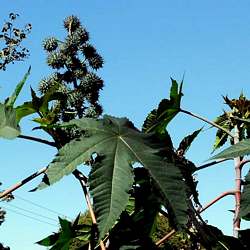 After
rounding the bend, we head south, back the way we came, but now in an
ever ascending arroyo. Here we find higuerilla (10), the castor oil
plant, which Guinness says is “the most poisonous plant in the world.”
It's also very common, growing on just about every empty lot in
Guadalajara. The seeds contain the deadly poison ricin. Six, if chewed,
can kill an ox. After
rounding the bend, we head south, back the way we came, but now in an
ever ascending arroyo. Here we find higuerilla (10), the castor oil
plant, which Guinness says is “the most poisonous plant in the world.”
It's also very common, growing on just about every empty lot in
Guadalajara. The seeds contain the deadly poison ricin. Six, if chewed,
can kill an ox.
Inside
the arroyo we find lots of gorgeous white flowers (in January and
February) called Heterocentron axillare Naudin (11), possibly agria in
Spanish. There are also plenty of delicate Polished Maidenhair Ferns
(12).
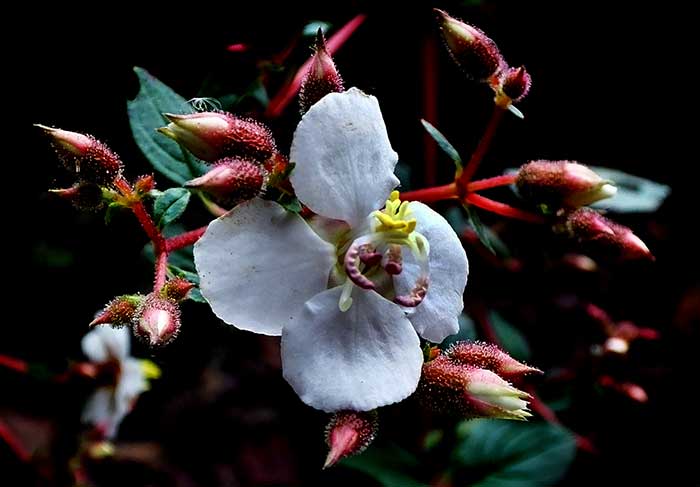
Beneath
a grove of bamboo (13), we may spot Ganoderma mushrooms growing on an
old log. These mushrooms thrive only on dead wood, which they help turn
into earth.
The arroyo
rises steeply and we come to the last station where we find Gordolobo
(14), a medicinal plant from which a tea is made to fight colds.
How to get there
Take
Avenida Vallarta west to the Periferico. Continue west 8 kilometers and
make a U-turn to enter Pinar de la Venta. Check Wikiloc.com under “Andador
Amistad Pinar Coche” to find your way to the trailhead
(N20.72428 W103.52780) and find “Andador
Amistad Pinar” on Wikiloc for the Virtual Interpretive Trail.
Driving time from Guadalajara is about 15 minutes if traffic is light.
|

